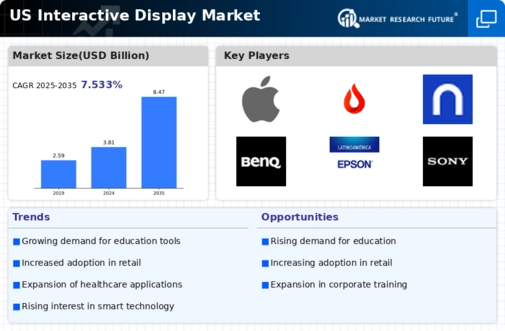Increased Investment in Smart Cities
The interactive display market is benefiting from increased investment in smart city initiatives across the United States. As urban areas strive to enhance public services and improve citizen engagement, interactive displays are being deployed in public spaces for information dissemination and wayfinding. These displays serve as vital tools for communication, providing real-time updates on transportation, events, and local services. The market for interactive displays in smart cities is projected to grow by 25% over the next few years, driven by government funding and public-private partnerships. This trend not only enhances the interactive display market but also contributes to the overall development of smart urban environments, making cities more connected and responsive to the needs of their residents.
Expansion of Digital Signage Solutions
the interactive display market is growing due to the expansion of digital signage solutions across various sectors. Businesses are increasingly recognizing the value of digital signage for advertising, information sharing, and enhancing customer engagement. Interactive displays serve as a dynamic medium for delivering content that can be updated in real-time, making them ideal for environments such as airports, malls, and corporate offices. The digital signage market is expected to grow by 18% annually, which will likely bolster the interactive display market as companies seek to integrate more interactive elements into their signage strategies. This trend indicates a shift towards more engaging and interactive communication methods, positioning the interactive display market as a key player in the digital transformation of businesses.
Rising Demand for Remote Collaboration Tools
The interactive display market is significantly influenced by the rising demand for remote collaboration tools. As organizations increasingly adopt hybrid work models, the need for effective communication solutions has become paramount. Interactive displays facilitate real-time collaboration, allowing teams to brainstorm, share ideas, and present information seamlessly, regardless of location. This trend is particularly evident in corporate environments, where interactive displays are being integrated into meeting rooms and collaborative spaces. Market analysis indicates that the demand for such tools is expected to increase by approximately 20% over the next five years, further propelling the growth of the interactive display market. Companies are investing in these technologies to enhance productivity and foster innovation, making them essential in the modern workplace.
Growing Focus on Customer Experience in Retail
The interactive display market is increasingly shaped by the growing focus on customer experience in retail environments. Retailers are adopting interactive displays to create engaging shopping experiences that attract and retain customers. These displays enable personalized marketing, product demonstrations, and interactive promotions, which can significantly enhance customer engagement. Recent studies suggest that retailers utilizing interactive displays can see an increase in sales by up to 30%. As competition intensifies, the need for innovative solutions to enhance customer experience is likely to drive further investment in the interactive display market. This trend reflects a broader shift towards experiential retail, where the shopping experience is as important as the products being sold.
Technological Advancements in Display Technology
The interactive display market is experiencing a surge due to rapid technological advancements in display technology. Innovations such as OLED and 4K resolution are enhancing visual quality, making displays more appealing for various applications. The integration of touch-sensitive surfaces and gesture recognition is also transforming user interaction, thereby increasing demand. According to recent data, the market for interactive displays is projected to grow at a CAGR of 15% from 2025 to 2030. This growth is driven by the need for more engaging and immersive experiences in sectors like education, corporate, and entertainment. As technology continues to evolve, the interactive display market is likely to see further enhancements, making it a pivotal component in modern communication and information dissemination.






















Leave a Comment